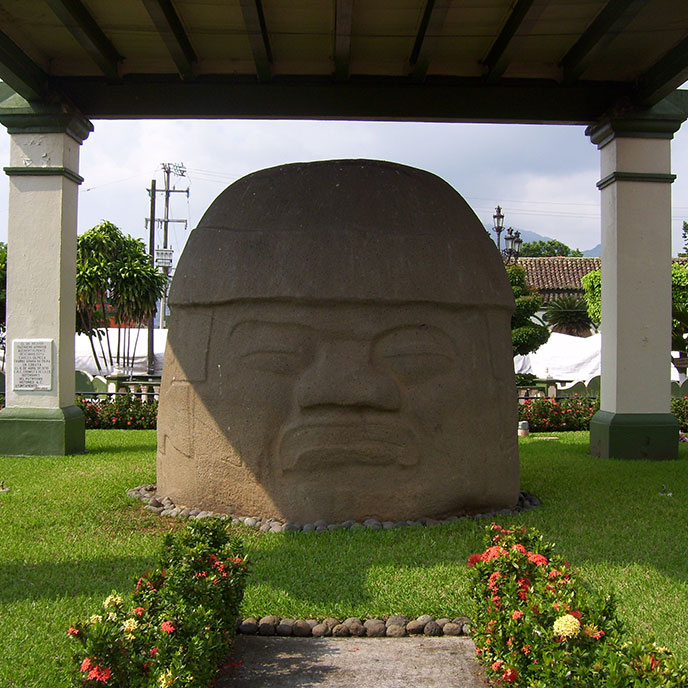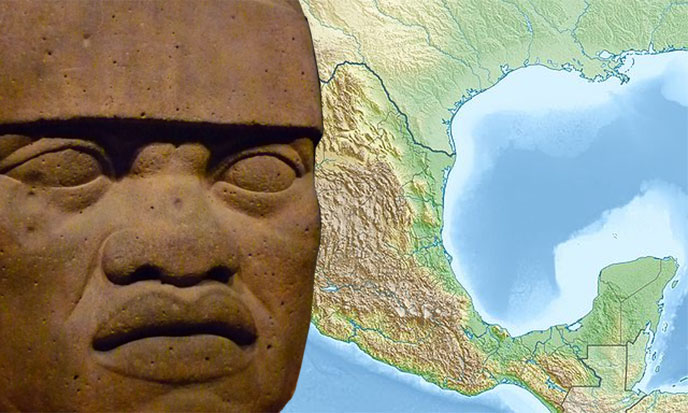
Among the unsolved archaeological mysteries, the pre-Columbian huge heads singularly alter our vision of the distant past of America and Africa. At the beginning of last century, several giant stone heads depicting warriors Negroid type were discovered in the jungles and chapparal of Mexico. What are they doing there, in the ancient Olmec territory, deep in the heart of the pre-Columbian Mesoamerica?
One wonders why and how Black Africans came to America at such a distant time? Archaeologists as historians are struck dumb on the subject. That would make them too many pages to rewrite in the old school textbooks.
Better to stick to the old version: Blacks have nothing to do with it. These statues are not Negroid, they argue. And yet …

In Santiago Tuxtla, old colonial town in Mexico, a small shaded park is the home of a very strange sculpture. This is a huge head of warrior, 10 feet high, known by the name of Head of Cobata. This sculpture, more than 2,000 years old, is clearly a man with negroid features. Not far from there, in Tres Zapotes, was discovered another giant head of African man. He also wears a helmet with chinstraps, like the first one. All features express a great nobility. One hundred years ago, excavations allowed to unearth seventeen of them, all of the same type. But the head of Cobata is the largest one.
Taradiddles and nonsense according to historians, for which there was at this time no black Africans in the Americas. If they have learned it, so it is true. So do they work… For the official history, the first blacks arrived 25 centuries later, with the slave trade. While Historians loudly claim that slaves were the first blacks in America, the sculpted heads suggest they were not.
Why couldn’t have black Africans successfully crossed the Atlantic in those remote times? Because Blacks were savages before the colonial invasion of Whites? This primary racism seems quite old fashioned and is becoming quite unbearable. Thus we must find a better hypothesis. Second guess : because the boats did not exist, say with one voice archaeologists and historians. Yet Plato thinks otherwise. He said the Atlanteans had long vessels to 10,000 BCEBefore Common Era.

The absence of evidence cannot be the evidence of absence. For example, we have always believed that the Pre-Columbians did not know the wheel. Yet the Olmec potters made toys with wheels. In the meantime, how to explain the presence of blacks in Meso-America?
This pot evoking a modern teapot is part of the Olmec objects found at La Venta. This is an elephant without discussion. If the Olmecs knew this African animal, doesn’t it mean they knew Africa? It is true that according to Plato, the island of Atlantis housed elephants.
Are the Olmecs from this wonderful island, they should leave, under duress, when the ocean has swallowed up? It is very likely, if they had boats to make the trip.
Another hypothesis: the Olmecs, courageous sailors, often went to Africa. Same objection: with what boats? The first known boats are much more recent. So what? Be patient, we will find really ancient remains sooner or later.

That could revive the hypothesis of an ancient black civilization in Africa. At the end of the Bronze Age, Egypt was ruled by a black dynasty, the Nubian pharaohs. It happens that the early Egyptians were great offshore sailors. One can imagine that even earlier, Africans were able to cross the Atlantic, as Quetzalcoatl, Viracocha, the Vikings, or St Brandan, the Templars or Christopher Colombus, who did not discover America in 1489, because, as Plato told us, it has always been known.
Mainstream historians tell funny stories.
History teaches historians how to falsify it.


